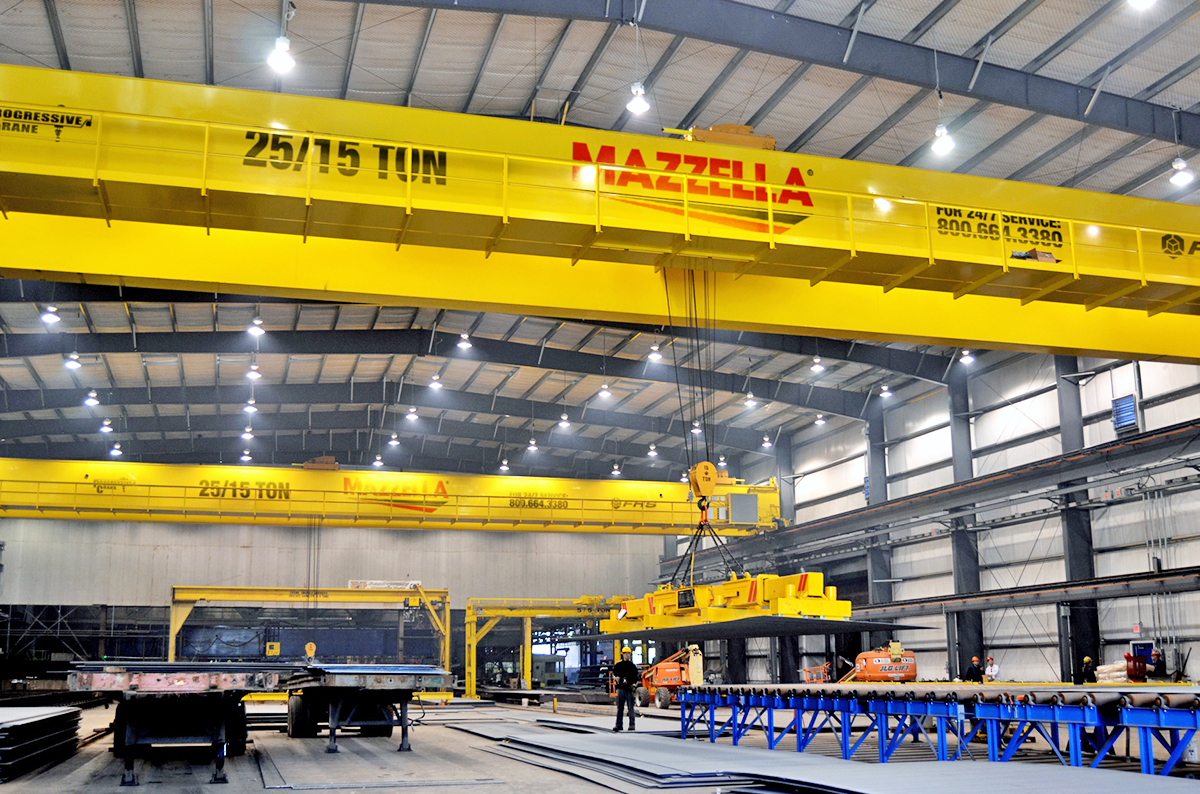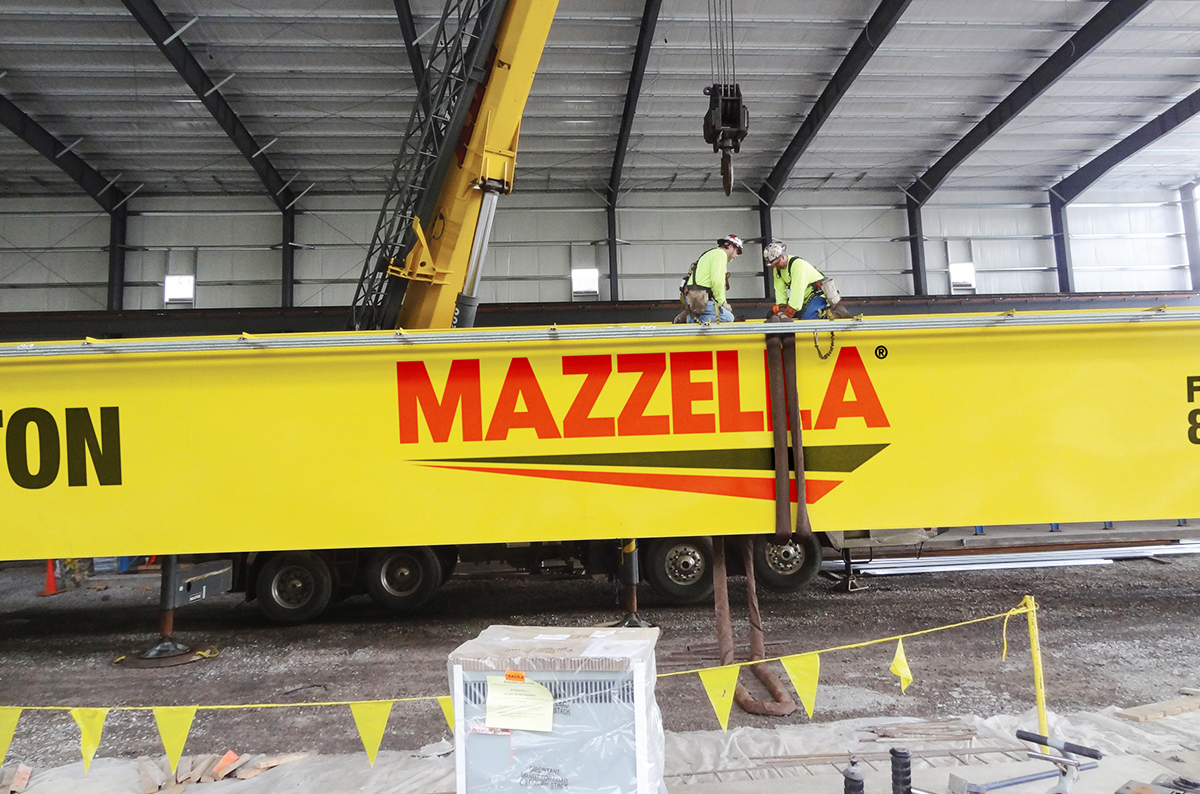What Is the Difference Between CMAA Cranes and FEM Cranes?
Understand how CMAA and FEM crane design standards differ, why it matters for your duty cycle, and how to choose the right system for your operation.
If you’re evaluating or purchasing an overhead crane, you’ll likely encounter two different design standards: CMAA (Crane Manufacturers Association of America) and FEM (European Federation of Materials Handling).
Both provide frameworks for how cranes are classified, designed, and rated for safe use. But, the way they categorize duty cycles, loads, and operating life is different.
Crane service classifications allow you to select and build an overhead crane that is the most economical and safest design for your lifting application. If you don’t understand those differences, you could either under-specify a crane that wears out too soon or over-specify a crane that costs far more than you need.
In this article, we’ll explain:
- What CMAA crane design means
- What FEM crane design means
- The key differences between the two systems
- A side-by-side comparison table
- How to choose the right standard for your operation
What Is CMAA Crane Design?

The Crane Manufacturers Association of America (CMAA) publishes specifications that are the benchmark for overhead cranes in the United States. These guidelines are referenced by crane manufacturers, engineers, and inspectors, and they are aligned with OSHA and ANSI safety standards.
CMAA divides cranes into six service classes based on duty cycle and application.
- Class A: Standby or infrequent service, such as cranes used in powerhouses.
- Class B: Covers cranes where service requirements are light, the speed is slow, and loads may vary from no load to occasional full rated loads. The average load is 50% of the rated capacity.
- Class C: Moderate service for environments like machine shops and paper mills, with 5 to 10 lifts per hour.
- Class D: Heavy service, including steel warehouses, fabricating plants, foundries, and heavy production shops.
- Class E: Severe service, such as scrap yards, lumber mills, fertilizer plants, and large foundries.
- Class F: Continuous severe service, designed for 24/7, high-capacity production.
CMAA classes are straightforward. By matching your crane to a class, you can quickly determine whether it’s suited for occasional use, moderate duty, or continuous heavy operation.
What Is FEM Crane Design?
The European Federation of Materials Handling (FEM) provides the equivalent set of standards for the European and international market. These rules are aligned with ISO and EN regulations and tend to be more detailed than CMAA.
FEM classifies cranes by combining two factors:
- Load spectrum – the percentage of time a crane will handle light, medium, heavy, or very heavy loads.
- Design working hours – the number of hours the crane is expected to operate over its service life.
By blending these two factors, FEM assigns designations such as 1Bm, 1Am, 2m, 3m, and 4m. For example:
- 1Bm is light service, around 400 operating hours per year.
- 2m is heavy service, about 1,600 hours per year.
- 4m is very heavy service, with more than 6,000 operating hours annually.
FEM ratings are more precise than CMAA because they calculate both time and load spectrum. This allows buyers to match crane design to very specific usage conditions.
CMAA vs. FEM: What’s the Difference?
| CMAA Class | FEM Class | HMI | ISO | Use | Typical Shift Operation | Load Spectrum | Approx. Lifts Per Hour |
| A | 1Cm | H1 | M2 | Light-duty | Single shift | Very light | Up to 2 per hour |
| B | 1Bm | H2 | M3 | Light-duty | Single shift | Maximum load lifted occasionally | Up to 2 per hour |
| C | 1Am | H3 | M4 | Light to medium-duty | Single shift | Maximum load lifted occasionally | 2-5 per hour |
| D | 2m | H4 | M5 | Medium to heavy-duty | One or two shifts | Medium to heavy loads | 5-10 lifts per hour |
| D | 3m | H4 | M6 | Heavy-duty | Two shifts | Heavy loads lifted regularly | 10-20 lifts per hour |
| E | 4m | H4 or H5 | M7 | Extremely heavy-duty | Two to three shifts | Heavy loads lifted regularly | 20+ lifts per hour |
| F | 6 | N/A | M8 | Extremely heavy-duty continuous operation | Loads lifted continuously | Heavy loads continuously | Continuous |
The difference between CMAA and FEM isn’t about which one is “right” or “wrong.” It’s about how each system defines crane usage and service life.
CMAA gives you a straightforward, broad-brush framework. If you know you’re running a repair shop or a steel warehouse, you can quickly find a matching class (A through F) based on typical duty cycles. This makes CMAA easy to apply, especially in early planning stages or when detailed usage data isn’t available.
FEM, on the other hand, is granular and calculation-driven. It looks at two dimensions at once—load spectrum and lifetime operating hours—so you can calculate exactly how many cycles and how much wear a crane should withstand. This makes FEM the go-to choice for companies that demand precision or operate across multiple facilities worldwide.
Both standards get you to the same goal, helping you build the right overhead crane for your company. They take different routes to get there.
CMAA vs. FEM Duty Cycle Equivalents
Although there is no official one-to-one mapping, the table below provides approximate equivalents that help bridge the two systems.
| CMAA Class | Typical Service | FEM Equivalent (Approx.) | Notes |
| A | Standby or infrequent use (powerhouses, infrequent lifts) | 1Bm | Very light service, ~400 design hours/year. |
| B | Light service (repair shops, light warehouses) | 1Am | Light-to-medium loads, ~800 design hours/year. |
| C | Moderate service (machine shops, paper mill machine rooms) | 1Am – 2m | Regular cycles with moderate loads. |
| D | Heavy service (steel warehouses, foundries, production shops) | 2m – 3m | Frequent handling of heavy loads, up to ~3,200 design hours/year. |
| E | Severe service (scrap yards, continuous heavy-duty environments) | 3m – 4m | Long duty hours, very heavy loads. |
| F | Continuous severe service (24/7 high-capacity production) | 4m | Designed for maximum service life in nonstop operations. |
Which Standard Should You Choose: CMAA or FEM?
The standard you select usually depends on your environment and business needs.
If you’re in the United States, CMAA is typically the default because it aligns with OSHA and ANSI. If you’re in Europe or a global operation, FEM is more common because it aligns with ISO and EN standards.
That said, multinational companies sometimes specify FEM even for U.S. facilities because of its precision and global consistency. Smaller operations in the U.S. often find CMAA sufficient, especially when they only need to match general application examples rather than precise calculations.
When choosing between CMAA and FEM, think about:
- Location and regulatory environment – Which codes govern your facility?
- Detail required – Do you need broad categories or detailed calculations?
- Supplier expertise – Does your crane provider specialize in one standard or both?
- Future operations – Will you scale operations to multiple facilities or countries?
Why This Choice Matters
The crane you specify affects both cost and service life. If you under-specify a crane by choosing too light of a class or group, you’ll deal with premature wear, breakdowns, and safety risks. If you over-specify, you could spend tens of thousands of dollars more than necessary on a crane that exceeds your needs.
The sweet spot is finding the right balance: a crane that can handle your load and duty cycle without overshooting on cost.
Practical Example
Let’s say you run a machine shop that uses a crane daily but not around the clock. Under CMAA, this would likely be a Class C crane, designed for moderate service. Under FEM, it might be classified as a 1Am or 2m, depending on how many hours it runs annually.
Now, imagine putting that same Class C crane into a 24/7 steel production environment—a setting that would demand a FEM 4m equivalent. The crane would quickly wear out, leading to unplanned downtime, costly repairs, and possible safety incidents.
Comparing Design Life of CMAA and FEM Crane Design

According to our experts, it’s also important to compare the design life between CMAA and FEM designs.
Design life is the projected amount of work, measured in cycles and hours, that an overhead crane can safely perform before the structural and mechanical components reach their fatigue limits and are no longer reliable.
CMAA classifies cranes by duty, and the system primarily focuses on average load intensity and the number of lift cycles. FEM also classifies cranes by duty but uses load spectrum and average daily operating time to determine the classifications and the resulting design life.
FAQs: CMAA vs. FEM Crane Design
Is one standard better than the other?
Neither system is “better.” CMAA is simpler and widely used in the U.S., while FEM is more detailed and preferred in Europe and global operations.
Can a crane be designed to meet both standards?
Yes. Many OEMs design cranes that comply with both CMAA and FEM. The key is ensuring the design matches your actual usage.
Do inspections differ based on CMAA vs. FEM?
Not significantly. Inspections focus on OSHA or local safety regulations. The design standard matters more for crane longevity than inspection protocol.
Which standard should I use for a global operation?
Multinational companies often use FEM for consistency, but the choice depends on your supplier network and facility requirements.
Final Thoughts

CMAA and FEM are two different languages describing the same idea: How much work will your crane need to do, and how long should it last?
If you’re in the U.S., CMAA is usually the natural fit. It’s simple, proven, and built into OSHA and ANSI codes.
If you’re operating in Europe or across multiple global sites, FEM gives you the precision and consistency to standardize crane performance across facilities.
For many companies, the best answer is to work with a supplier who understands both—and can help you balance safety, performance, and cost without overspecifying or underspecifying.
The stakes are high. Choosing the wrong class or group can mean downtime, safety risks, or wasted capital. But when you get it right, your crane lasts longer, performs better, and protects your workforce.
Make sure your crane is designed for your actual duty cycle—and partner with experts who can translate those requirements into the right standard for your facility.
At Mazzella, our team is incredibly knowledgeable on CMAA and FEM standards, and they can assist you in getting the right crane for your organization’s needs. Contact Mazzella’s overhead crane experts today.
Copyright 2025. Mazzella Companies.


